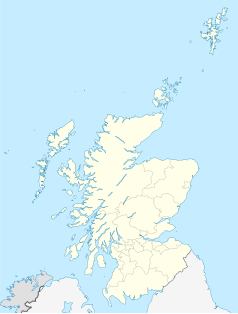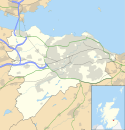Forth Bridge
 Forth Bridge od południa (2012) | |
| Państwo | |
|---|---|
| Kraj | |
| Miejscowość | Queensferry/North Queensferry |
| Podstawowe dane | |
| Przeszkoda | |
| Długość | 2 528,7 m |
| Data budowy | 1882–1890 |
Położenie na mapie Edynburga Contains Ordnance Survey data © Crown copyright and database right, CC BY-SA 3.0 | |
Położenie na mapie Wielkiej Brytanii (c) Karte: NordNordWest, Lizenz: Creative Commons by-sa-3.0 de | |
Położenie na mapie Szkocji | |
| Obiekt z listy światowego dziedzictwa UNESCO | |
(c) George Gastin, CC BY-SA 3.0 | |
| Państwo | |
|---|---|
| Typ | kulturowy |
| Spełniane kryterium | I, IV[1] |
| Numer ref. | |
| Region[b] | Europa i Ameryka Północna |
| Historia wpisania na listę | |
Forth Bridge – most kolejowy we wschodniej Szkocji, przerzucony nad zatoką Firth of Forth, pomiędzy miejscowościami Queensferry i North Queensferry. Wraz z biegnącymi równolegle mostami drogowymi Forth Road Bridge i Queensferry Crossing zapewnia komunikację między Edynburgiem na południu a hrabstwem Fife na północy. Most, według projektu inżyniera Johna Fowlera, zbudowano w latach 1879–1890. W 2015 roku został wpisany na listę światowego dziedzictwa UNESCO[2].
Konstrukcja
Most o długości całkowitej wynoszącej 2,5 kilometra składa się z trzech masywnych filarów o konstrukcji kratownicowej w kształcie rombu oraz czterech mniejszych wiaduktów. Każdy romb ma 110 metrów wysokości, natomiast rozpiętość pomiędzy nimi wynosi 521 metrów.
Ruch pociągów przebiega w odległości 50 metrów od lustra wody, co praktycznie uniemożliwia wpływanie większych statków w głąb lądu. Do budowy zużyto około 54 000 ton stali, którą zamocowano przy użyciu 6,5 mln nitów.
Przypisy
- ↑ The Forth Bridge, UNESCO World Heritage Centre [dostęp 2017-11-23] (ang.).
- ↑ Wpis na listę UNESCO
Media użyte na tej stronie
(c) Karte: NordNordWest, Lizenz: Creative Commons by-sa-3.0 de
Location map of the United Kingdom
(c) Eric Gaba, NordNordWest, CC BY-SA 3.0
Location map of Scotland, United Kingdom
Flag of the United Nations Educational, Scientific and Cultural Organization (UNESCO)
Contains Ordnance Survey data © Crown copyright and database right, CC BY-SA 3.0
Blank map of Edinburgh, UK with the following information shown:
- Administrative borders
- Coastline, lakes and rivers
- Roads and railways
- Urban areas
Equirectangular map projection on WGS 84 datum, with N/S stretched 175%
Geographic limits:
- West: 3.47W
- East: 3.05W
- North: 56.05N
- South: 55.80N
Autor: Kim Traynor, Licencja: CC BY-SA 3.0
The Forth Bridge seen from South Queensferry
Forth Bridge (1890) Portrait of John Fowler, Plate 1
(c) George Gastin, CC BY-SA 3.0
A late night view of the Forth Rail Bridge from the shore of South Queensferry















